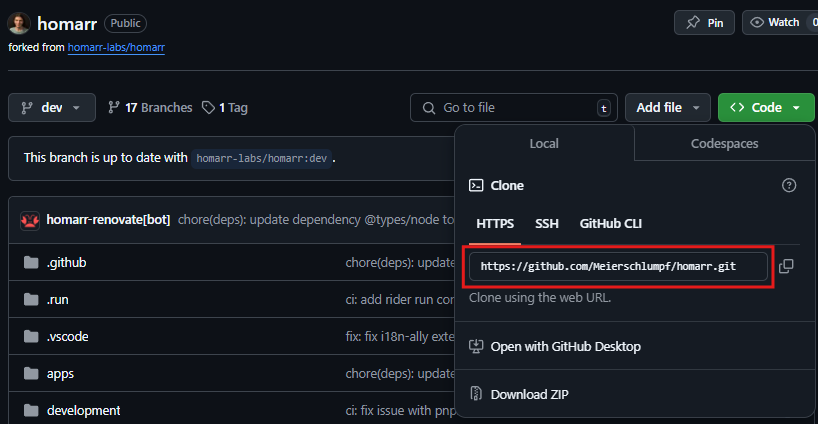Getting started
Setting up your development environment
This guide will help you set up your development environment to start contributing to homarr.
Prerequisites
- Node.js (lts): You can download it from the official website.
- pnpm (latest): You can install it by running
npm install -g pnpm. - Git: You can download it from the official website.
- Docker or Docker Desktop: You can download it from the official website.
- A GitHub account: You can create one on the official website.
Setting up the project
- Fork the repository by clicking on the "Fork" button on the top right corner of the repository page.

- Clone the repository to your local machine with
git clone. You can find the url to use by clicking on the "Code" button on the top right corner of your forks repository page.

-
Change directory to the project folder with
cd homarr. -
Install the dependencies with
pnpm install. -
Start redis by running
pnpm run docker:dev. This will run a docker-compose file with a redis service. -
Copy the
.env.examplefile to.envand replaceDB_URLwith the full path you want to use for the sqlite database file. For exampleDB_URL='C:\\Dev\\homarr\\packages\\db\\db.sqlite' -
Run the migrations to create the sqlite db file with
pnpm run db:migration:sqlite:run. -
Start the development server with
pnpm devand wait for a message that says✓ Ready in 10.7s -
Open your browser and navigate to http://localhost:3000. (Loading the page might take up to 2 minutes the first time)
Useful npm scripts
During development
pnpm dev: Start the development server.pnpm cli: Run cli commands.pnpm db:migration:sqlite:run: Run the migrations to create or update the sqlite db file.pnpm db:migration:sqlite:generate: Generate a new migration file for the sqlite db. Also works withmysql.pnpm db:studio: Open a visual studio for the database.pnpm package:new: Create a new package in the monorepo.
Checking code quality
pnpm lint: Run the linter to check for code quality issues.pnpm format:fix: Run the formatter to fix code style issues.pnpm test: Run the tests. You can also usepnpm test:uito get a UI for the tests.pnpm typecheck: Run the typescript type checker.
Building the project
pnpm build: Build the project for production.docker build -t homarr .: Build a docker image for the project.docker run -p 7575:7575 -e SECRET_ENCRYPTION_KEY='your_64_character_hex_string' homarr:latest: Run the created docker image.